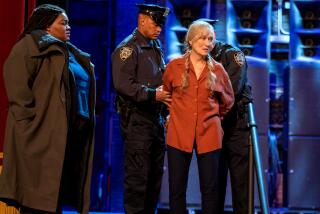‘Prescription’ Results From an Under-Dose of ‘Rent’
- Share via
There are several misconceptions made in public health physician Alice Glasser’s “prescription” for “Rent” that need to be cleared up (“A Doctor Writes New Prescription for Musical ‘Rent,’ ” Counterpunch, Oct. 13).
First, Glasser implies that one of the characters, Angel, a transvestite, irresponsibly withholds information about his HIV status when he attempts to seduce another man, Collins. But Glasser missed an important exchange between Angel and Collins.
When Angel meets Collins for the first time, he sings, “This body provides a comfortable home for the acquired immune deficiency syndrome,” to which Collins replies, “As does mine.” Thus each become aware that the other is infected with HIV.
Second, Glasser implies that two heterosexual characters, Roger and Mimi, fail to tell each other they are HIV-positive before they become sexually involved. This is not true. In the song “La Vie Boheme,” Mimi announces boldly after a beeper goes off, “AZT Break!,” whereupon everyone on stage--including Roger--takes their AZT. Roger and Mimi then turn to each other in disbelief. “You?” Roger asks. “Me,” Mimi responds. “You?”
This is followed by “I Should Tell You,” which Glasser mistakenly takes as a song saying that they can’t--or won’t--tell each other of their HIV status. Had she heard the preceding lines she would have realized that this is a song about their true feelings for one another, one that expresses their fears and hesitancy toward getting involved as well as their individual needs to express their desires and love for one another. Obviously, their being ill adds another poignant layer to the normal fears every couple has when beginning a new relationship.
In addition to these scenes, in Act 2, the song “Contact” specifically deals with the message of safe sex.
Much of Larson’s writing is based on true experiences he had with many close friends who were infected and died of this disease. He was all too well aware of the dangers and horrors of AIDS. (Larson himself died at the age of 35 of an aortic aneurysm.)
To gain a better understanding of the play’s intentions, Glasser or others might want to read the hard-bound “Rent” book that goes into depth about the passion and compassion that went into telling an emotional tale that encompasses all aspects of what people deal with in confronting HIV.
It also has the complete libretto, which could help clear up Glasser’s concerns for what she perceives as Larson’s “cavalier approach” to the spread of AIDS.
I will say in Glasser’s defense that there is a lot of information to digest in 2 1/2 hours, and much could be missed. However, I am certain that is why Larson chose to set the important information shared by Angel and Collins as well as Mimi and Roger in the sparest, most uncluttered musical moments in the show.
In the case of Angel, it is to a simple piano accompaniment, and with regards to Mimi and Roger, there is a musical gap when the line is spoken.
My “prescription” for Glasser is see the show again. She may be surprised how much she has missed. (And judging by her comments, it is a considerable amount.) Then maybe she will realize that what is being said and sung on stage is well thought out and conceived to convey a message of hope transcending the caution and suffering that this era of epidemic has brought to the young people of today.
But this is not just a show about HIV and AIDS. It’s a story of love and redemption of spirit. It’s a story about life one day at a time: “No Day but Today!”
HIV and AIDS just happen to be a part of the plot line.
More to Read
The biggest entertainment stories
Get our big stories about Hollywood, film, television, music, arts, culture and more right in your inbox as soon as they publish.
You may occasionally receive promotional content from the Los Angeles Times.










